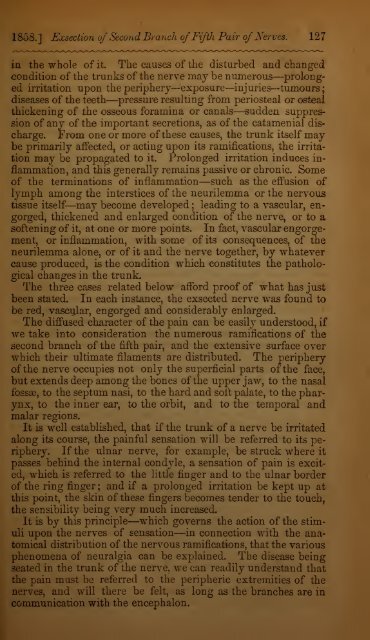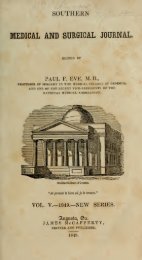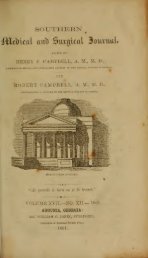1858.] Exsection of Second Branch of Fifth Pair of Nerves. 127in the whole of it. The causes of the disturbed <strong>and</strong> changedcondition of the trunks of the nerve may be numerous — prolongedirritation upon the periphery—exposure—injuries—tumours;diseases of the teeth— pressure resulting from periosteal or ostealthickening of the osseous foramina or canals—sudden suppressionof any of the important secretions, as of the catamenial discharge.From one or more of these causes, the trunk itself maybe primarily affected, or acting upon its ramifications, the irritationmay be propagated to it. Prolonged irritation induces inflammation,<strong>and</strong> this generally remains passive or chronic. Someof the terminations of inflammation—such as the effusion oflymph among the interstices of the neurilemma or the nervoustissue itself—may become developed ; leading to a vascular, engorged,thickened <strong>and</strong> enlarged condition of the nerve, or to asoftening of it, at one or more points. In fact, vascular engorgement,or inflammation, with some of its consequences, of theneurilemma alone, or of it <strong>and</strong> the nerve together, by whatevercause produced, is the condition which constitutes the pathologicalchanges in the trunk.The three cases related below afford proof of what has justbeen stated. In each instance, the exsected nerve was found tobe red, vascular, engorged <strong>and</strong> considerably enlarged.The diffused character of the pain can be easily understood, ifwe take into consideration the numerous ramifications of thesecond branch of the fifth pair, <strong>and</strong> the extensive surface overwhich their ultimate filaments are distributed. The peripheryof the nerve occupies not only the superficial parts of the face,but extends deep among the bones of the upper jaw, to the nasalfossae, to the septum nasi, to the hard <strong>and</strong> soft palate, to the pharynx,to the inner ear, to the orbit, <strong>and</strong> to the temporal <strong>and</strong>malar regions.It is well established, that if the trunk of a nerve be irritatedalong its course, the painful sensation will be referred to its periphery.If the ulnar nerve, for example, be struck where itpasses behind the internal condyle, a sensation of pain is excited,which is referred to the little finger <strong>and</strong> to the ulnar borderof the ring finger; <strong>and</strong> if a prolonged irritation be kept up atthis point, the skin of these fingers becomes tender to the touch,the sensibility being very much increased.It is by this principle—which governs the action of the stimuliupon the nerves of sensation—in connection with the anatomicaldistribution of the nervous ramifications, that the variousphenomena of neuralgia can be explained. The disease beingseated in the trunk of the nerve, we can readily underst<strong>and</strong> thatthe pain must be referred to the peripheric extremities of thenerves, <strong>and</strong> will there be felt, as long as the branches are incommunication with the encephalon.
128 Exsection ofSecond Branch ofFifth Pair of Nerves. [February,From these views, we can perceive how futile the operation ofdivision of the nerve at the foramen infra-orbitale must be fWhere the trunk of the nerve is extensively diseased, no operationcan rationally lead to a successful result, unless all thebranches emanating from the trunk are cut off from communiscation with the brain.I believe that, in such aggravated cases of neuralgia, the keyof the operation is the removal of the ganglion of Meckel, or its in^sulationfrom the encephalon.^-Wheie even a large portion of thetrunk of the second branch of the fifth pair has been simply exsectedfrom the infra-orbital canal, the ganglion of Meckel continuesto provide to a great extent the nervous ramifications,which will still maintain <strong>and</strong> keep up the diversified neuralgicpains. Besides, the ganglion of Meckel, being composed ofgray matter, must play an important part as a generator of nervouspower, of which, like a galvanic battery, it affords a continualsupply ; while the branches of the ganglion, under the influenceof the diseased trunk, serve as conductors of the accumulatedmorbid nervous sensibility.Case I.—Henry Rousset, a French physician, residing inGreenesborough, Caroline County, Maryl<strong>and</strong>, consulted me inthe early part of October, 1856, for severe neuralgia, which hadfor several years rendered him incapable of following his profession.He was of nervous temperament, good constitution, <strong>and</strong>sixty -nine years of age.The disease first made its appearance in September, 1851,commencing with severe <strong>and</strong> lancinating pains about the regionof the left cheek <strong>and</strong> orbit. These pains continued for five orsix days, <strong>and</strong> then disappeared, leaving him almost free fromthem for about four months. At the expiration of that time,the neuralgic pains again returned with more violence, extend*ing over the region of the left cheek, <strong>and</strong> continuing almostwithout intermission, for more than a week. After this exacer?bation, the patient again became comparatively free from painfor a short interval ; after which, the attacks returned with in-rcreased severity, <strong>and</strong> were renewed with greater frequency, moreespecially in the cold season, <strong>and</strong> in damp weather. As thedisease progressed, the pain was not confined alone to the eye<strong>and</strong> cheek, but would also attack the lip <strong>and</strong> nose ; each paroxrysm being of longer duration than the preceding. "With butslight variation, the disease went on this way to harass <strong>and</strong> dis*tress the patient for four years. About the commencement ofMarch, 1856, the neuralgic exacerbation assumed a more violentform, marked by excruciating <strong>and</strong> almost unremitting suffering.He was at this time unable to eat, drink, converse, or laugh,without having a most violent paroxysm, causing him to shriek
- Page 1 and 2:
SOUTHERNMEDICAL AND SURGICAL JOURNA
- Page 3 and 4: ——76 Campbell's Lecture on Dyse
- Page 5 and 6: :75 CAMPBELL'S Lecture on Dysentery
- Page 7 and 8: •80 Campbell's Lecture on Dysente
- Page 9 and 10: .82 Campbell's Lecture on Dysentery
- Page 11 and 12: —84 Campbell's Lecture on Dysente
- Page 13 and 14: 86 Campbeli/s Lecture on Dysentery.
- Page 15 and 16: 88 CAMPBtfLl/s Lecture on Dysentery
- Page 17 and 18: 90 Campbell's Lecture on Dysentery.
- Page 19 and 20: 92 Eve's Notes on Diseases of the C
- Page 21 and 22: the94 Eve's Notes on Diseases of th
- Page 23 and 24: 96 Eve's Notes on Diseases of (lie
- Page 25 and 26: 98 Eve's Notes on Diseases of the C
- Page 27 and 28: 100 Eve's Notes on Diseases of the
- Page 29 and 30: :102 Eve's Notes on Diseases of the
- Page 31 and 32: 104 Eve's Notes on Diseases of the
- Page 33 and 34: :106 Report upon the Topography and
- Page 35 and 36: ;108 Report upon the Topography and
- Page 37 and 38: 110 Report upon the Topography and
- Page 39 and 40: 112 Report upon the Topography and
- Page 41 and 42: 114 On Rheumatism. [February,system
- Page 43 and 44: —116 On Rheumatism. [February,d 0
- Page 45 and 46: 118 On Rheumatism. [Februaryarus pr
- Page 47 and 48: 120 On Rheumatism, [February,Opium
- Page 49 and 50: 122 On Rheumatism. [February,head l
- Page 51 and 52: !;124 On Rheumatism. [February,not
- Page 53: —126 Exsection ofSecond Branch of
- Page 57 and 58: 130 Exsection ofSecond Branch ofFif
- Page 59 and 60: ;132 Exsection ofSecond Branch of F
- Page 61 and 62: ;134 Exsection ofSecond Branch ofFi
- Page 63 and 64: slightfiveswelling;136 ExsectionofS
- Page 65 and 66: —138 Editorial. [February,will sh
- Page 67 and 68: 140 Editorial. [February,the roof o
- Page 69 and 70: 142 Editorial. [February,the nutrit
- Page 71 and 72: 144 Editorial. [February,attach exc
- Page 73: —106 Editorial and Miscellaneous.








